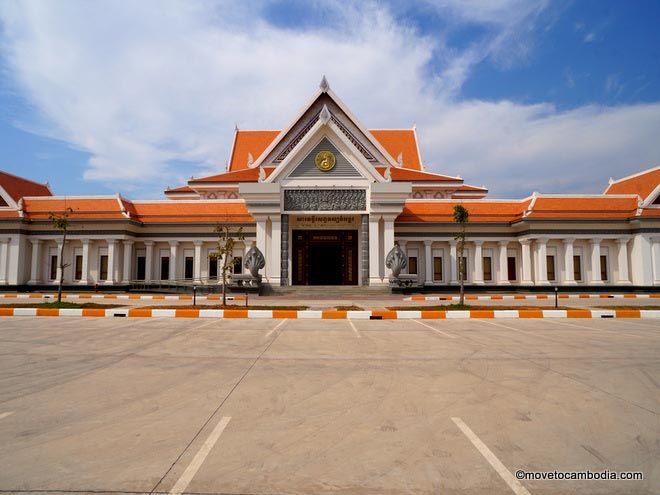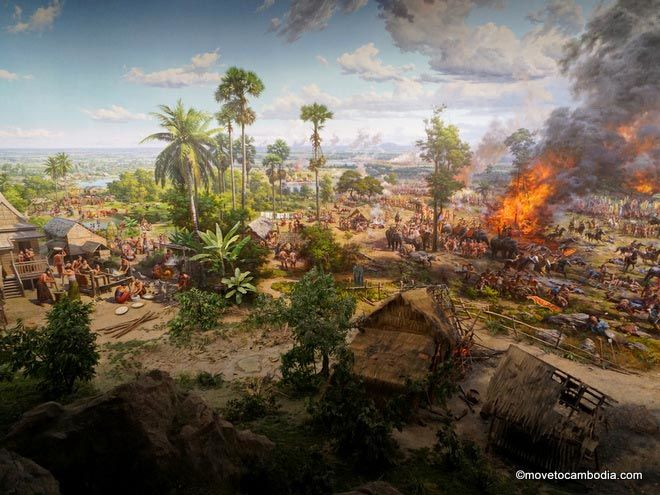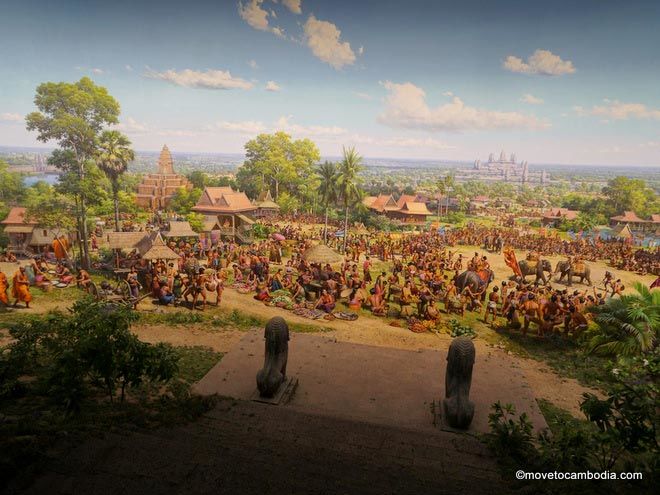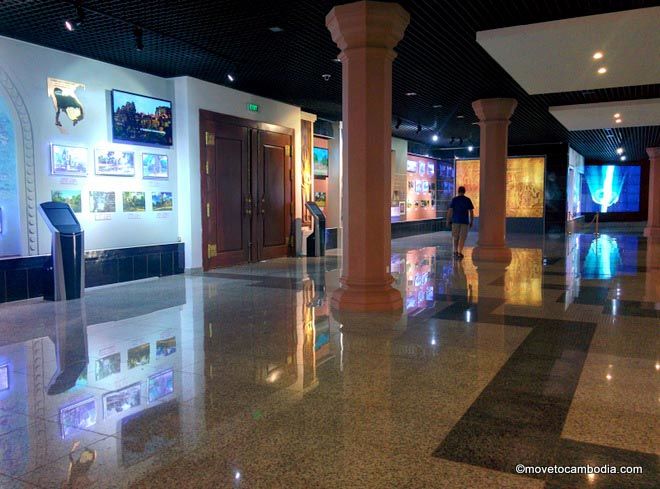Update: As of December, 2019, the Angkor Panorama Museum is closed, reportedly due to UN sanctions on North Korea that required member states to send North Korean workers home in mid-December.
When we crossed the vast, empty parking lot in front of Siem Reap’s new Angkor Panorama Museum and stepped up to the front door, a young museum employee rushed to meet us. “May I help you?” she asked warily, as if we’d accidentally wandered into a restricted area. Her greeting, at once polite and slightly sinister, proved emblematic of the entire Panorama Museum experience.

The new North Korean Angkor Panorama Museum is hardly a teeming hive of activity.
Built and maintained by the Democratic People’s Republic of Korea at a reported cost of $24 million, the place is less a museum than a showcase for one gigantic artwork: a panoramic painting 120 meters (nearly 400 feet) in diameter and 13 meters (42 feet) high, equivalent in size to three basketball courts.
The painting fills the building’s cylindrical central space with depictions of Cambodia’s history: Jayavarman VII’s bloody and ultimately victorious battle against invading Champa forces in the 12th century, his construction of the Bayon temple in the aftermath, and prosperous village life in his Angkor empire.
A spectacular example of the social-realist heroic, the panorama is the work of North Korea’s Mansudae art studio, famous for creating outsized and hysterically idealized depictions of the country’s rulers and workers. The panorama’s gruesome vignettes of hand-to-hand combat, its scenes of happy villagers bringing crops to market and of hard-working artisans creating temple carvings are simultaneously photorealistic and fantastical. As meticulous as the painting itself is the three-dimensional trompe l’oeil foreground of trees, rocks, and human and animal figures that seamlessly create the illusion that the viewer is inside the painting’s world.

The panorama decidedly more impressive in real life than in photos, and stunningly realistic.
When visitors climb up to the viewing platform in the middle of the panorama, a guide materializes to explain its historic and artistic details. Our guide told us that 63 Mansudae artists labored for nearly two years to complete the panorama, which has some 45,000 distinct figures. (We neglected to ask whether that number is only the people, or the myriad elephants, horses, and other animals as well.)
While we admired the painting, another museum employee with a large camera around his neck lurked in the background. His presence was never explained, but we noticed that he visibly tensed whenever one of our party pulled out her phone, then relaxed when he saw she was only answering a text. Taking pictures in the museum is strictly forbidden, and this being a North Korean enterprise, the rule is enforced with utmost strictness. The camera wearer’s job appeared to be to make sure that no one else committed an act of photography.

The simultaneously photorealistic and fantastical scenes took more than two years to paint.
Once we’d studied the panorama at length, which took us about 20 minutes, there proved to be not much else to see. The building’s main hall presents a detailed miniature model of the Angkor Wat temple complex and a few informative placards about its history and construction. Another gallery showed several dozen not particularly interesting paintings of landscapes and smiling people, presumably by Mansudae artists.
We could have watched a 20-minute 3D movie showing how the temples were built, but the museum charges $5 for the movie, in addition to the steep $15 apiece we’d already paid to spend 20 minutes with the panorama, which felt like more than enough cash to drop into Kim Jong-Un’s pocket. (Those are barang prices; Cambodians are charged $8 for the panorama, $3 for the movie.)
We appeared to be the museum’s only visitors for most of the afternoon, and wherever we went we were trailed by several pink-shirted museum staff, some Cambodian, some from the DPRK. Our efforts to engage one of the young North Korean women working in the snack bar and gift shop in some entirely anodyne conversation (“How long have you been in Cambodia? How do you like it here?”) provoked such visible anxiety in both her and her colleague that we quickly abandoned gestures of international friendship, paid for our souvenirs, and hurriedly left the premises.
The DPRK already has a network of restaurants in despot-friendly countries — Cambodia has a long history of friendship with North Korea — that are widely understood to be a way for the isolated, impoverished country to gain desperately needed foreign currency that international sanctions have otherwise placed out of reach. The Angkor Panorama Museum presumably has the same goal, which perhaps explains the high ticket price. (Prices in the gift shop, however, were surprisingly reasonable.)

The main hall of the museum with exhibits about the temples
The museum opened at the beginning of 2016 and will be operated by North Korea until 2026 or until it recoups the $24 million construction costs, whichever comes first. Eventually both the museum and its revenues will be handed over to Apsara, the agency that oversees the Angkor temple complex and the temples’ ever-growing tourism business.
Visitors will have to make their own moral calculation about spending money that will likely help support Kim Jong-Un’s heinous dictatorship or foregoing the chance to experience the panorama and the museum’s intriguingly paranoid atmosphere. Skeptical about sanctions, and about moral outrage that targets some heinous dictatorships and gives others a free pass, we opted to check the museum out. But since we were almost the only paying customers there, it was hard to feel that Pyongyang was getting much benefit from our custom.
Next to the museum is another new building, a large hall that reportedly will soon become the main ticketing station for the Angkor temples. One Apsara official told the New York Times that diverting some of the tourist influx to the Angkor Panorama Museum could reduce the tourist impact on the temples themselves. Apparently the hope is that instead of journeying out to the temples, a substantial number of tourists will opt instead to spend an air-conditioned hour in the Panorama Museum and then retire back to their hotels.
Expecting people to pay $20 — the same price as an all-day admission to the temple complex — for what little the museum offers seems delusional, however. But clearly the regime responsible for creating this odd tourist attraction doesn’t inhabit quite the same reality as the rest of us.
Angkor Panorama Museum
Open daily, 7 a.m. til noon, 1 p.m. til 9 p.m.
Road 60, Sangkat Slorkram, Siem Reap
T: 063 76 52 63; 096 54 95 530
www.angkorpanoramamuseum.com
Originally published April 19, 2016
After reading this article, I decided not to go to this museum. I will never ever support North Korea for whatever they do especially in this country or anywhere else. I can’t believe Cambodia is letting them do this!
Speachless.